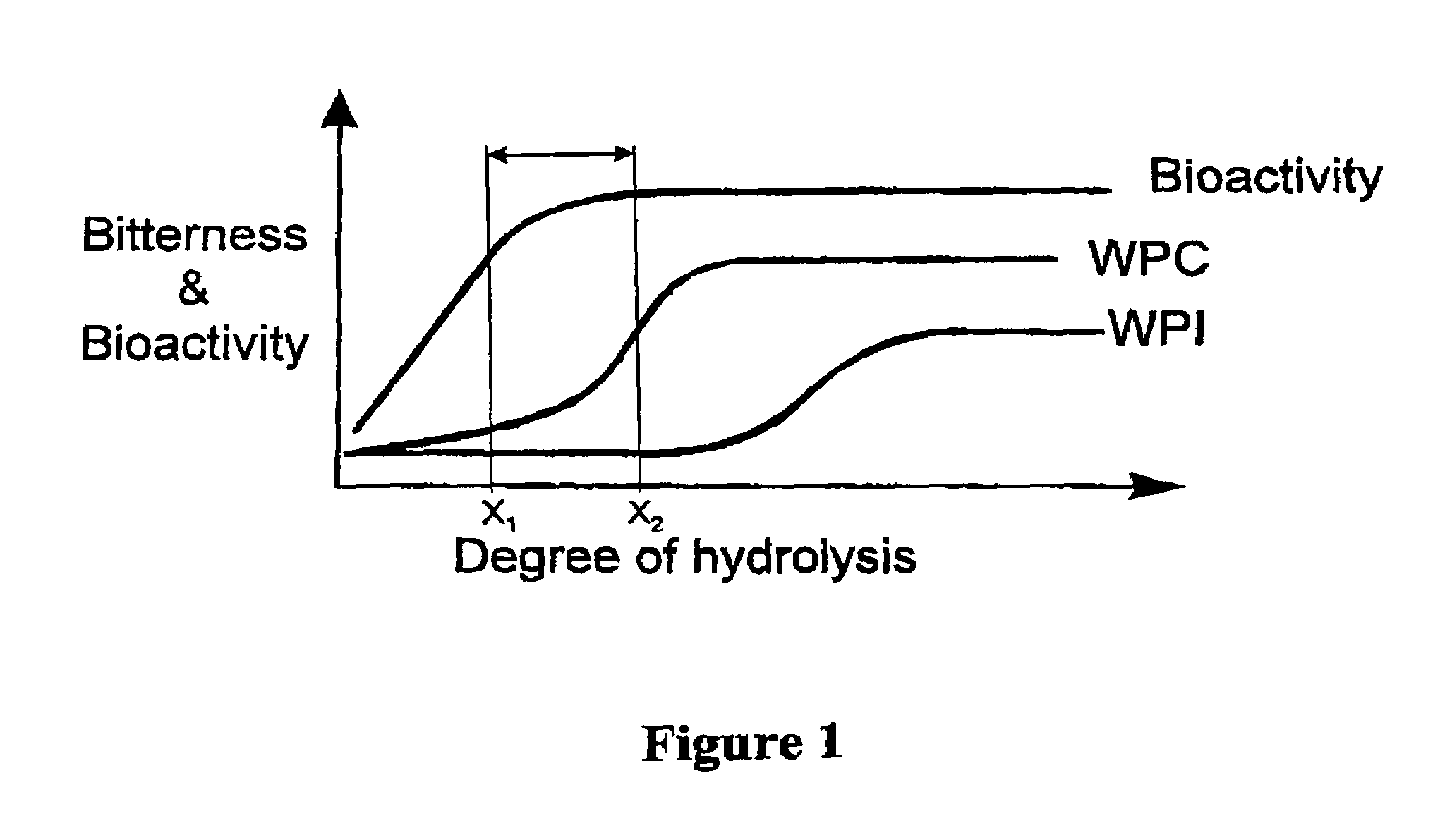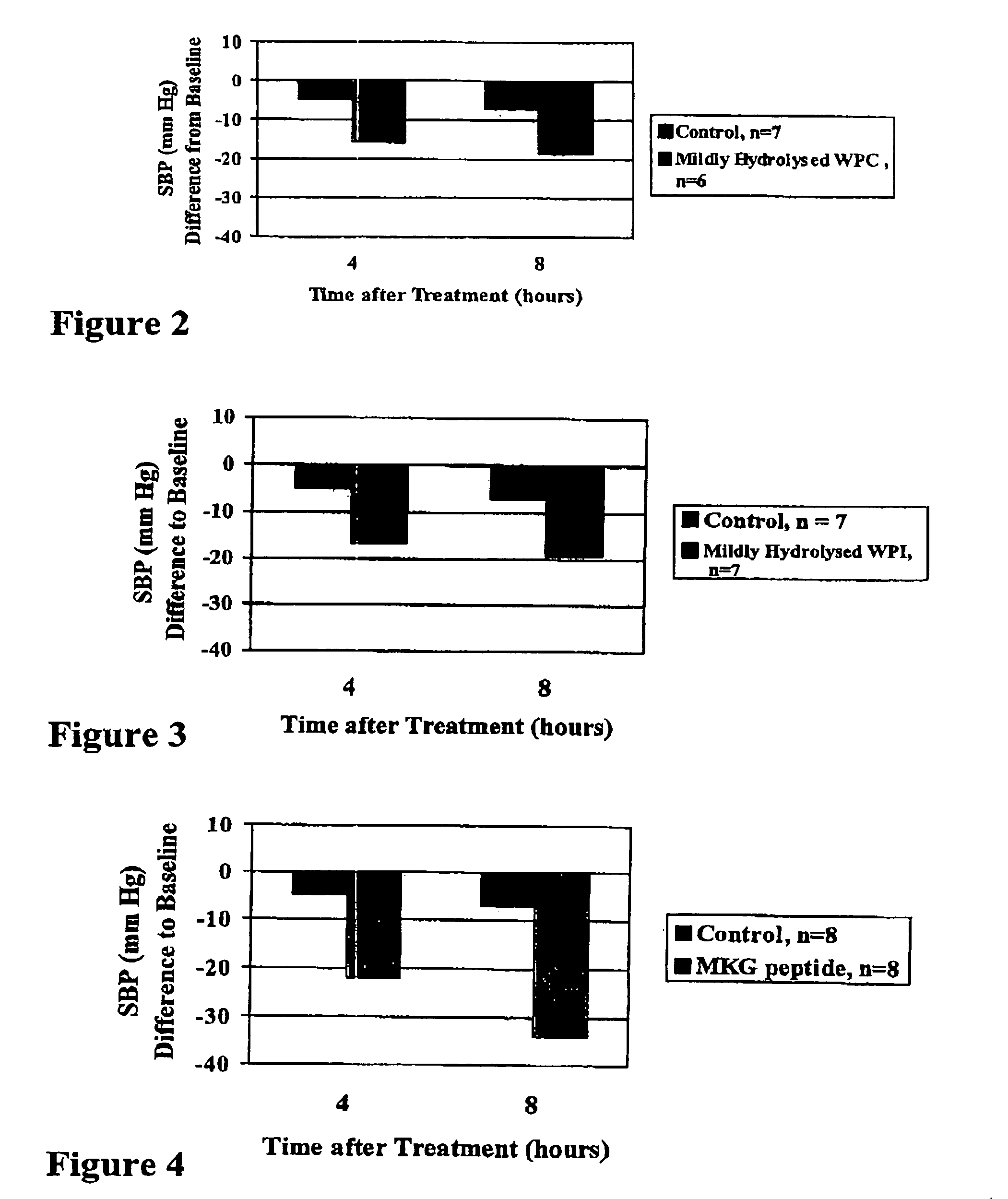Bioactive whey protein hydrolysate
a technology of whey protein and hydrolysate, which is applied in the field of bioactive whey protein hydrolysate, can solve the problems generating bitterness, and causing palatability, and achieving the effect of reducing the chain length of all peptides by extensive hydrolysis
- Summary
- Abstract
- Description
- Claims
- Application Information
AI Technical Summary
Benefits of technology
Problems solved by technology
Method used
Image
Examples
example 1
Pilot Plant Production of WPI Mild Hydrolysate
[0103]Whey protein isolate produced by cation ion exchange technology (ALACEN™ 895) with a protein content ≧90% w / w was reconstituted at 20% total solids in water (50° C.) Reconstituted ALACEN™ 895 was transferred to a 150 L tank at 50° C. Water (50° C.) was added to the tank to make final total solids of 4%. The solution was stirred and Neutrase (E:S 0.9%) was added.
[0104]Two hours after enzyme addition the first hydrolysate was pumped through the UHT plant. Enzyme inactivation was achieved using direct steam injection to heat the hydrolysate to 88° C. and the hydrolysate was held it at this temperature for 1.5 seconds.
[0105]The hydrolysate was flash cooled and passed through shell and tube heat exchanges to cool to ambient temperature.
[0106]The hydrolysate was subsequently evaporated and dried.
[0107]A hydrolysate made following the process of Example 1 had the following features:
[0108]Solubility: 95%
[0109]Heat stability: 120° C. for 10...
example 2
[0117]The hydrolysis reaction was repeated as outlined above for Example 1(10% total solids, E:S 0.9%, 150 L). After inactivation the hydrolysate was immediately evaporated and dried
[0118]A hydrolysate made by this method had the following features which were measured as disclosed above for Example 1:
[0119]Solubility 97%
[0120]Heat stability: 120° C. for 10 min @5% TS solubility 96%
[0121]ACE-I in vitro activity: 503 mg / L IC50
[0122]Foaming: Markedly increased over non-hydrolysed WPI
[0123]Gelling: Markedly increased over non-hydrolysed WPI
[0124]Flavour: Markedly improved over WPC based mild hydrolyses
[0125]Appearance: clear yellowish
example 3
[0126]The hydrolysis reaction of Example 1 was repeated as outlined above (4% total solids, E:S 0.9%, 150 L). Four hours after enzyme addition the first hydrolysate was pumped through the UHT plant using the same conditions as in Example 1.
[0127]A hydrolysate made by is method had the following features which were measured as disclosed above for Example 1:
[0128]ACE-I in vitro activity: 230 mg / L IC50
[0129]Foaming: Markedly increased over non-hydrolysed WPI
[0130]Gelling: Markedly increased over non-hydrolysed WPI
[0131]Flavour: Markedly improved over WPC based mild hydrolysates
[0132]Appearance: clear yellowish
PUM
 Login to View More
Login to View More Abstract
Description
Claims
Application Information
 Login to View More
Login to View More - R&D
- Intellectual Property
- Life Sciences
- Materials
- Tech Scout
- Unparalleled Data Quality
- Higher Quality Content
- 60% Fewer Hallucinations
Browse by: Latest US Patents, China's latest patents, Technical Efficacy Thesaurus, Application Domain, Technology Topic, Popular Technical Reports.
© 2025 PatSnap. All rights reserved.Legal|Privacy policy|Modern Slavery Act Transparency Statement|Sitemap|About US| Contact US: help@patsnap.com


